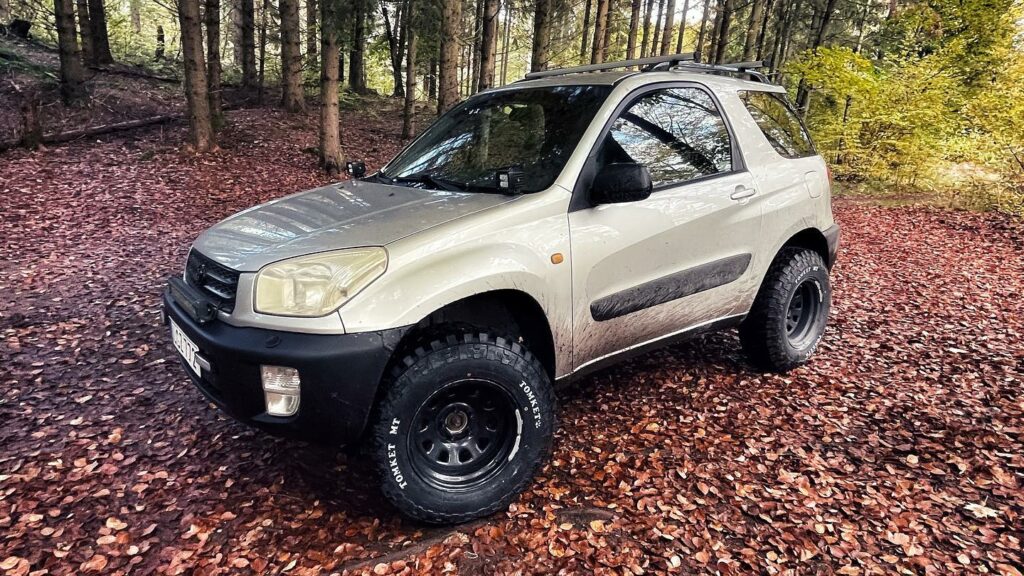Off-Road Capabilities of the 2nd-Gen Toyota RAV4
When you’re headed off-road, the choice of vehicle can significantly impact your experience.
This article will delve into the strengths and weaknesses of the second-generation Toyota RAV4 (2001-2005) as a light-duty off-road vehicle.
We’ll explore its off-road capabilities, specifications, overlanding potential, suggested modifications, and insights from RAV4 owners who’ve ventured off the beaten path.

Off-Road Capabilities
The second-generation Toyota RAV4, produced from 2001 to 2005, is known for its versatility.
While primarily designed for on-road use, Toyota’s compact SUV does offer some off-road potential thanks to specific features and specifications.
AWD/2WD
The 2nd-gen RAV4 was available in both AWD and 2WD configurations.
We recommend starting with the AWD version (which Toyota marketed as 4WD), which utilizes a full-time AWD system with a viscous coupling center differential.
This system transfers power between the front and rear wheels as needed, improving traction in slippery conditions. While it’s not a dedicated off-roader, this system provides an advantage when venturing off-road.
Ground Clearance
Ground clearance is crucial for off-roading, as it determines the vehicle’s ability to traverse uneven terrain.
The AWD versions of the 2nd-gen RAV4 offer a respectable 6.7 inches of ground clearance, which is suitable for light off-roading but falls short for more challenging terrain. The 2WD version is 6.3 inches, which is less than ideal.
Approach and Departure Angles
The RAV4’s approach angle (the steepest slope a vehicle can climb without hitting its front bumper) is 29.3 degrees, and its departure angle (the steepest angle a vehicle can descend without contacting its rear bumper) is 25.4 degrees.
These angles are suitable for light off-roading and moderately challenging terrain but may pose limitations in rugged conditions.
Suspension
The second-generation RAV4 features a four-wheel independent suspension, with a MacPherson front setup and a rear wishbone suspension.
While the independent front suspension is excellent for light off-roading, it may not withstand the rigors of rugged terrain, potentially leading to suspension damage.
Engine Specs
The 2nd-gen RAV4 has a 2.0L inline-four engine producing 150 horsepower (2001-2003) or a 2.4L 4-cylinder 150 hp engine in 2004-2005 models.
More important for off-roading is torque. The more, the better. The 2.0L engine develops 142 lb.-ft @ 4,000 rpm while the 2.3L produces 165 lb.-ft @ 4,000 rpm.
While these engines offer decent power for everyday driving, they may struggle in challenging off-road conditions that demand more torque and low-end grunt.
Compact Size
The RAV4’s compact size works best when navigating tight trails and narrow paths.
It’s more maneuverable than larger SUVs, making it a valuable asset in off-road environments that require precision.
Downhill Assist Control (DAC)
Some RAV4 versions came equipped with Downhill Assist Control (DAC), which helps maintain a steady and controlled speed when descending steep slopes, which enhances the RAV4’s off-road capability and safety, especially when tackling downhill sections.
(2005 Toyota RAV4 Owner’s Manual)
Overland Capability
Overlanding is a self-reliant form of adventure travel to remote destinations where the journey is the primary goal. It often involves extended periods of camping and driving to remote locations.
Let’s explore how the 2nd-gen fares in this context and if you should overland with your RAV4.
Fuel Efficiency and Gas Tank Size
The RAV4’s fuel efficiency, with variations depending on the model year, ranges from 19-22 city mpg, 24-28 highway mpg, and a combined 21-24 mpg.
With the 14.8-gallon gas tank capacity, this fuel efficiency is crucial for overlanding, where gas stations may be few and far between.
Towing Capacity
The RAV4 boasts a 1,500 lbs. towing capacity, which can be advantageous for overlanders who need to pull small trailers loaded with supplies for extended journeys.
Reliability
Second-generation RAV4s have garnered excellent reliability ratings, making them dependable choices for overlanding.
Regular maintenance is vital to ensuring continued reliability, especially considering the age of these vehicles.
Payload
Payload capacity varies depending on the model but typically falls between 1,041 to 1,091 lbs.
This payload capacity is essential for safely carrying gear and supplies during overland adventures.
Pros and Cons
Let’s summarize the pros and cons of using a 2nd-gen RAV4 as an off-roader.
Pros:
- 4WD versions are beneficial for off-roading.
- The compact size enhances maneuverability on narrow trails.
- The more powerful 2004-2005 model year engines are better suited for off-roading.
Cons:
- Ground clearance may limit capabilities in moderate and strenuous off-roading.
- Earlier 4-cylinder engines may struggle in challenging terrain.
- The automatic transmission lacks a low range for navigating rugged terrain or getting unstuck.
Available Modifications

There are many modifications available that enhance the off-road and overland abilities of a 2nd-gen RAV4:
Tires:
Tires available in the OEM P215/70R16 size include the popular BFGoodrich All-Terrain T/A KO2 and the well-regarded Falken WildPeak A/T Trail.
With a lift kit installed, P245/70R16 tires can be fitted on the OEM rims. These tires are 2.5″ taller than OEM, raising ride height by 1.25″.
Some boards mention P255/65R16, but we don’t recommend that size with the OEM rims as it’s outside the manufacturer’s recommended wheel width range.
Lift Kit:
Lifting your RAV4 increases ride height, improving ground clearance and approach/departure angles. However, it decreases fuel mileage, raises the center of gravity, and generally affects handling.
There are two methods by which you can lift a 2nd-gen RAV4:
Leveling Lift Kit – this method involves inserting spacers within the front spring and rear leaf springs. While this is an inexpensive strategy to raise a 2nd-gen RAV4, it relies on springs and shocks designed for a smooth street ride over off-road performance.
Full Lift Kit – involves replacing the front and rear springs and shocks with those designed for off-roading. While a Leveling Lift Kit is less expensive, a Full Lift Kit significantly increases off-road capabilities.
One Full Lift Kit we’re excited to present is from the Australian off-road experts at Old Man Emu (whose shocks are factory-fitted to the 2024 Tacoma Trailhunter).
The Old Man Emu kit includes front and rear springs and rear shocks. Unfortunately, OME doesn’t manufacture front struts for the 2nd-gen RAV4. However, there are plenty of great choices from Bilstein, Rough Country, and others.
Roof Rack:
A roof rack provides extra storage space for gear and supplies during overlanding trips. They are convenient for carrying tents, storage containers, and recovery equipment.
While the OEM roof racks are okay for strapping down a fresh-cut Christmas tree, they’re not captious enough to carry much equipment while overlanding.
What you need is a Rooftop Cargo Carrier to attach to the factory roof rack cross bars.
Some of its advantages over using OEM roof rack by itself are the flat floor that helps keep the load steady and the 4″ side walls to keep bags secure. It’s powder-coated steel for durability and is lightweight and easy to install.
Exhaust System:
An aftermarket exhaust system can enhance durability, airflow, and clearance, as they are manufactured from more durable materials, like stainless steel.
Trailers:
If you need additional storage capacity, towing a trailer under the RAV4’s towing capacity limit can be a practical solution.
While small, lightweight trailers come in under the 2nd-gen RAV4’s 1500 lb. trailer towing capacity, some can run as high as $15,000 to $20,000 new.
While purchasing used is one alternative to sticker shock, we’ve found a reasonably priced trailer that checks the boxes.
The teardrop Rustic Trail Koala Bear comes in at $9991 and is standard with an a/c and heater, led interior lighting, outside table, electric brakes, a 5-foot interior ceiling, and an 8-foot interior length.
Insights from RAV4 Owners
To provide a well-rounded perspective, here are some insights from RAV4 owners who have explored off-road adventures.
The consensus is that the 2nd-gen RAV4 is better suited for light off-roading. Some users highlighted the vehicle’s limitations, such as its lack of low range and vulnerability to underbody damage in rugged terrain.
Others emphasized the importance of knowing the vehicle’s capabilities and investing in aftermarket mods for better off-road performance.
Here are some direct quotes:
On Reddit, user 1phresphprince posted in response to whether 2nd gen RAV4 is suitable for light off-roading, “I wouldn’t do it, but that’s not to say ppl haven’t, rav4 has weak axels and it’s AWD, not 4WD. Anything more than light overlanding (packed earth, light mud, loose, small, small rocks) will likely break stuff pretty quickly. It’s a get-around-town car that’ll give you peace of mind when snow and bad weather come about; most AWD cars fall into that category.”
On rav4world forum, user Dr. Dyno posted in response to the 2nd Gen RAV4 picture, “Most “serious” off-road vehicles have higher ground clearance and a low range in the transfer case for slogging thru mud and rocks. From your pictures, you haven’t yet gotten into the serious, rough crawling stuff, just some of what I’d call rough dirt roads. For that, the RAV4 is fine. When you get into places where the tires sink such that you have to “power out of it, ” you’ll start overheating the transmission and risk ripping expensive stuff off the bottom.”
Maintenance and Care
For a 2nd-gen RAV4 used for off-roading, regular maintenance is essential. After every off-road trip, perform the following checks:
- Clean the vehicle to remove mud, dirt, and debris.
- Inspect tires, suspension, axles, and shocks for damage.
- Check engine and fluid levels to ensure optimal performance.
Expert Tip
We recommend that you fully understand the limitations of your 2nd-gen RAV4. Start with less challenging terrain and gradually progress to more difficult trails.
Please don’t push the vehicle beyond its capabilities. And always carry extra supplies, recovery gear, and tools.
Frequently Asked Questions
Summary
In summary, the 2nd generation Toyota RAV4, particularly the 2004-2005 models, can be a capable light-duty off-road vehicle with its compact size, AWD system, and reasonable ground clearance.
However, it’s essential to recognize its limitations and invest in suitable modifications for more demanding off-roading. The 2nd-gen RAV4 will never be a serious off-roader, even with substantial modifications.
Instead, with the 2nd-gen RAV4, you can enjoy light off-road and overlanding experience with proper maintenance and a realistic understanding of its capabilities.
Would you go off-roading in a 2nd-gen RAV4? Let us know in the comments below!

